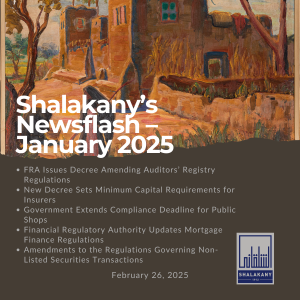In light of the increasing reliance on technology by businesses due to the COVID-19 pandemic, it is highly fitting that the amended Executive Regulations of the Law concerning Electronic Signatures and establishing the Information Technology Industry Development Agency (“ITIDA”) were very recently promulgated (the “Regulations”). This comes at a time when minimal human interaction measures have been globally adopted and, thereby, technology is progressively becoming more important for regular day-to-day transactions, communication, and document formation.
The Regulations were issued by virtue of the Ministry of Communications and Information Technology’s Decree No. 361 for the Year 2020 and published in the Official Gazette on 23 April 2020. The Regulations amend the previous Executive Regulations issued by Decree No. 109 for the Year 2005 (the “Old Regulations”).
Although it is convenient that the Regulations have been enacted during the COVID-19 pandemic, it is no coincidence that its enactment comes just over a month after the Egyptian Court of Cassation announced a milestone judgement with regards to the admissibility of emails as means of evidence in court.
Prior to delving into the key provisions of the amended Regulations, it is important to firstly provide an outlook on the aforementioned judgement.
Court of Cassation Judgment
Under Egyptian Law, the traditional written documentation and wet ink signatures have been the overriding legally recognizable mechanisms used in court proceedings. However, the Egyptian Court of Cassation (the “Court”) has indicated a shift in this approach by deciding, in its Judgement No. 17689 of Judicial Year 89, that it is no longer permissible to deny the authenticity of emails as evidence provided that they meet the technological and technical requirements of the Law No. 15 of the Year 2004 concerning Electronic Signatures (the “Law”). Although the judgement targets email communications, its implications on the wider electronic mediums are undeniable, as the Court’s reasoning explores the fundamental reason why electronically-created documents should not be legally refuted unless forgery is involved, alleged by one of the disputing parties and proven before the competent court.
In its judgement, the Court reveals that the word ‘document’, from a legal standpoint, was never limited to what was written on paper alone as the legislator’s sole requirement to establish proof is a correlation between the relevant document and its purported owner. As such, the Court confirms that this necessitates the acceptance of all means of documentation, whether written or electronic, as evidence.
Furthermore, the Court explains that the enactment of certain provisions of the Law prove the legislator’s intention to verify the authenticity of electronic writing as evidence provided it satisfies the technical controls and requirements outlined in the Law and its Executive Regulations. This indicates the legislator’s desire to keep pace with global technological developments in civil, commercial, and administrative transactions by organizing and setting controls for them in order to regulate their legal effects.
While the Court’s ruling, as outlined above, was strongly welcomed by concerned parties, especially companies that are considerably involved in transnational business and, as a result, carry out a significant portion, if not the entirety, of its communications with foreign parties via email and other electronic means of communication, it is important to emphasize one caveat: not all email communications will be accorded the same weight by courts as means of evidence. Only those emails that meet the conditions outlined in the Law and its Regulations will be admitted and accorded weight by courts as means of evidence within the ambit of civil, commercial and administrative transactions. And, in addition to the various other conditions outlined in the Law and the Regulations for electronic communications to carry weight as means of evidence, there must exist an electronic signature that belongs to the originator of the ‘document’, and that electronic signature must be issued by one of the companies that have a valid license from ITIDA. According to information on ITIDA’s official website, there are currently four entities that have licenses from ITIDA to carry out activities and provide services related to electronic signatures.
Below is a brief summary of the key aspects of the new Regulations:
Advancing the Existing Electronic System
The most notable amendment in the Regulations is the broadening of the electronic tools that regulate electronic communications under the umbrella of the Law. The Law originally established (a) electronic signatures (“E-signatures”), (b) electronic writing and (c) electronic documents as the three legally recognizable mediums that are subject to the provisions of the Law and its Regulations. The amended Regulations have now established the following tools:
Electronic Seal
This is defined as an electronic signature that allows for the identification of a juridical person (i.e. the seal creator) and distinguishes it from other juridical persons.
Electronic Time Stamp
This is what is placed on an electronic document and takes the form of letters, numbers, symbols, signs or other that link that data to a specific time to prove the existence of the electronic document at that specific time.
E-Signature Tool
This secure electronic medium enhances the E-signature process as it will be used in creating and installing an E-signature on an e-document through the use of smart cards, separate electronic chips or other systems that are identical in achieving the required functions (subject to the technical and technological requirements within the Regulations).
What is clear from these additions is that the legislator has sought new tools to ensure the authenticity of electronic communications and documents. From a legal standpoint, these new electronic tools work to safeguard the position of parties entering into agreements by adding strict requirements aiming to minimize the likelihood of any misconduct, forgery or other forms of manipulation that threaten the legitimacy of electronically-concluded documents.
New Condition for E-Signature Creation
The Old Regulations established six strict conditions that must be fulfilled to ensure that the system for forming data associated with E-signature creation is secure. This includes, inter alia, exclusivity and secrecy of the E-signature creation data and protection of the E-signature against forgery, imitation, perversion, or any other forms of manipulation.
The new Regulations add a further condition that heightens the control and security associated with E-signature creation. In this regard, it is now required that the system links the E-signature with the electronic document in a unique manner that prevents any undetected modification after the signature process.
The Way Forward
The Regulations establish new electronic tools and enhance the provisions regarding the authenticity of the mediums in a manner that aims to safeguard the rights of parties using electronic documents.
Although the Court’s judgement has paved the way for the admissibility of emails (and potentially other electronic documentation) under Egyptian Law, it is still unclear how this will be implemented in the near future. Concerned parties (i.e., companies and merchants that frequently conduct their dealings and transactions via emails and other electronic means) are advised to take precautionary measures to ensure that they can benefit from the Law and its Regulations when a dispute arises and issues of proof become highly relevant.



